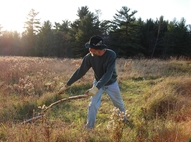|
First let's start with how NOT to mow with a scythe. I hope Enne doesn't mind, but this video is such a typical example of how most people instinctively swing a scythe, that I would like to utilize it for educational purposes. Most beginners swing the scythe through the air, and slash and hack at the tall grass and weeds, just like in the above video. This would be fine with a primitive scythe, like the Japanese scythe (more of a long handled sickle), but with the more sophisticated Austrian scythe that she is using here, she is wasting a lot of energy, and could very easily damage the thin metal edge of her blade. The Austrian scythe is a very sophisticated mowing tool. I say it over and over again; the Austrian scythe blade has 3 curves. The slashing and hacking that most people want to do with a scythe, would only require one curve: the crescent shape. The Austrian scythe blade has three curves for a reason. Form = Function. The three curves (which I call the crescent, the rocker, and the belly) enables the blade to slide over the ground, without the tip or the cutting edge, hitting the dirt. The rocker enables the blade to slide over the ground, without tip digging into the dirt. The belly enables the cutting edge to stay off the ground, when it's sliding forward on its belly. Therefore, to utilize the Austrian scythe blade effectively, keep it flat on the ground at all times! Slide it forward in the direction that the tip is pointing, and let it follow the contours of the ground. The edge cuts the grass by shearing it off near its base. I created this zany "Demo on Snow" video below, so that you can clearly see how the blade slides on the ground. When actually mowing on grass, the cutting action will lift the blade slightly off the ground, but the mower does not have to hold it up in the air. Rather, the mower may have to counter-act the lifting effect with a slight downward pressure on the lower grip, when mowing in a full field stroke. Thick stems, and/or very dense grass (such as a well fertilized, bluegrass lawn) will increase the need, for a downward pressure on the lower grip. Also a very fast and athletic, full field-stroke, requires a bit more downward pressure. How much downward pressure is a relative and variable thing. When mowing a cover crop in the garden, just the weight of the blade seems to be enough pressure. When I mow orchard grass or dense bluegrass I press down quite a bit. If I'm mowing new grass growing out of thick thatch, I use very little downward pressure, so that the blade will slide up and over the thatch. I didn't have the space to address all this in the mowing video below. I just say, "Keep your hands relaxed. The grips should float in your hand." What I would like to add, is that while your right hand is relaxed, you add the downward pressure at a diagonal, as required, with the palm of your right hand, as you move the scythe to the left. At the same time your right wrist has to be responsive, to the blade's following the contours of the ground. You pull on the snath with the fingers of your left hand, while your left wrist is stabilizing the what your right wrist is responding to. Sound complicated? No, it's actually all just one beautiful, fluid, and co-ordinated motion. Once you've got it, you will just want to keep going and going. It's the joy of scything.
0 Comments
Your comment will be posted after it is approved.
Leave a Reply. |
Botan AndersonArchives
March 2023
Categories
All
|

 RSS Feed
RSS Feed